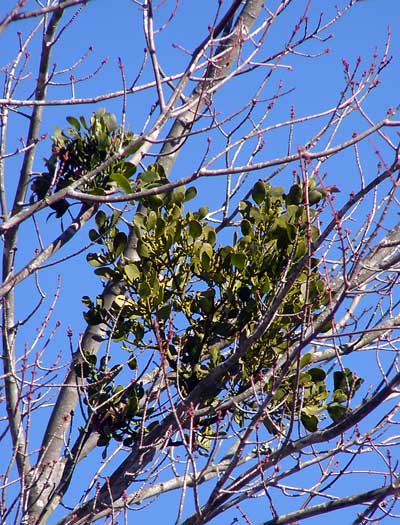Mistletoe in the news
Flora Columnist
Mistletoe was in the news last week. An article in Raleigh’s News & Observer described mistletoe gathering from canoes; there was mention in Flora that mistletoe might appear on Carrboro’s giant wreath (and it is, hanging up beneath the triple red bow); Chapel Hill News pictured the Carrboro Town wreath, including mention of mistletoe; and a friend shared the Guardian’s story describing the increasing rarity of mistletoe in England.
The story from the Guardian is worth a long pause:
“Conservationists warn today that mistletoe, favourite plant both of pagans and stealers of Christmas kisses, could vanish from the nation’s halls and doorways within 20 years.â€
The National Trust fears that the decline of traditional apple orchards may cause this curious plant to disappear or, at least, be much harder to obtain. European mistletoe, Viscum album, a tree parasite, is prolific in English apple orchards. National Trust ecologist Peter Brash the Guardian that such a result would be a sad loss: “Mistletoe is part of our Christmas heritage and has a special place in a wonderful winter landscape.â€
The Guardian wrote that environmental consultant and mistletoe expert Jonathan Briggs, a traditionalist who keeps mistletoe in his house all year to ward off evil spirits, said that “mistletoe would migrate to bigger, non-orchard trees and so become harder to reach. This could turn it into a much more expensive product or prompt people to rely on cheaper foreign imports. ‘A Christmas kiss could become more expensive.’â€
Well now, our own native mistletoe, Phoradendron serotinum, is already expensive, unless you happen to find it easy to pick low down in a nearby maple tree, as was my good fortune. That impressive bundle of mistletoe on the Carrboro wreath is hanging higher than it was in that maple. Nature was generous this time.
Accounts of mistletoe’s medicinal, sacred and magical attributes abound. It has a centuries-old heritage as a cure for epilepsy and other nervous disorders, but I’m not eager to give it a try. I do, however, find appeal in a combination of other attributes, dating back to druidic pre-Christian European cultures. Hanging sprigs of mistletoe inside all year long, from New Year to New Year, to insure prosperity as well as protection from witches and evil spirits is a tradition I will try.
Our native mistletoe is unlikely to be considered under threat of rarity as in England. It’s very common down east and frequently found here in the lower Piedmont. You’ll even spy it in town. Look for it in oaks along Franklin Street. You’ll see it in abundance in the ash trees on the UNC campus behind University Methodist Church.
Though a parasite, it does sport leaves, and is quite capable of photosynthesis and providing for some of its own needs. The plant spreads from tree to tree, carried by birds cleaning their beaks of the sticky seed coating.
As I am guarded about the location of my favorite female persimmon trees, I’m not about to disclose the location of the tree that sports female, berry-producing, mistletoe low down enough for me to reach.
I wish you luck with your own mistletoe search and may your whole year be free of witches and evil spirits.
Email Ken Moore at flora@carrborocitizen.com.




Comments are closed.